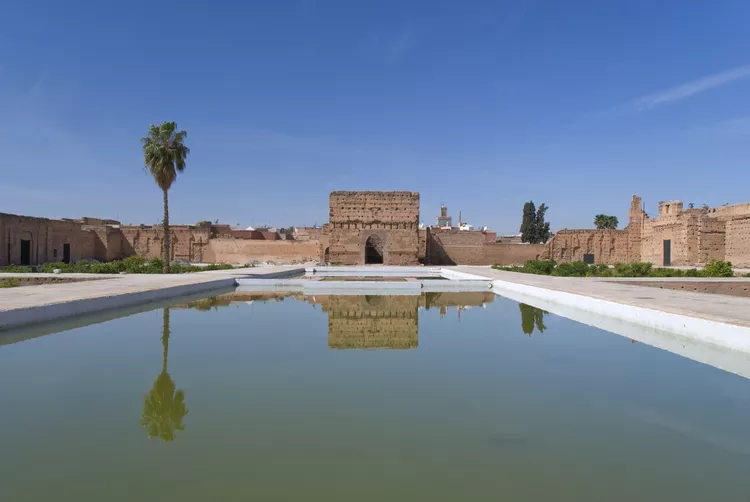Located to the south of Marrakesh’s historic medina, El Badi Palace was commissioned by the Saadian Sultan Ahmad el Mansour towards the end of the 16th century. Its Arabic name roughly translates as “the incomparable palace”, and indeed it was once the most splendid edifice in the city. Although the palace is now a shadow of its former glory, it nevertheless remains one of Marrakesh’s most famous sights.
History of the Palace
Ahmad el Mansour was the sixth sultan of the famous Saadi Dynasty and the fifth son of the dynasty’s founder, Mohammed ash Sheikh. After his father was murdered in 1557, el Mansour was forced to flee Morocco with his brother Abd al Malik to escape harm at the hands of their eldest brother, Abdallah al Ghalib. After 17 years in exile, el Mansour and al Malik returned to Marrakesh to depose al Ghalib’s son, who had succeeded him as Sultan.
Al Malik took up the throne and reigned until the War of the Three Kings in 1578. This conflict saw al Ghalib’s son attempt to regain the throne with the help of the Portuguese King Sebastian I. Both the son and al Malik died during the war, leaving el Mansour as al Malik’s successor. The new Sultan ransomed his Portuguese captives and, in the process, accumulated substantial wealth, which he decided to use to build the greatest palace Marrakesh had ever seen.
The palace took 25 years to complete and is thought to have included no fewer than 360 rooms. In addition, the complex included stables, dungeons, and a courtyard with several pavilions and a vast central pool. During its heyday, the pool served as a brilliant oasis, measuring approximately 295 feet/90 meters in length. The palace was utilized to entertain dignitaries from all over the world, and el Mansour took full advantage of the opportunity to showcase his wealth.
El Badi Palace was once a showcase of exquisite craftsmanship adorned with the most expensive materials of the era. From Sudanese gold to Italian Carrara marble, the palace was so spectacular that when the Saadi Dynasty eventually fell to the Alaouites, it took Moulay Ismail over a decade to strip El Badi of its treasures. Unwilling to allow el Mansour’s legacy to persist, the Alaouite Sultan reduced the palace to ruins and utilized the looted goods to enhance his own palace at Meknes.
The Palace Today
Thanks to the ravages of Moulay Ismail’s anti-Saadian campaign, visitors to El Badi Palace today need to use their imagination to recreate the complex’s former splendor. Instead of snowy marble columns and walls inlaid with onyx and ivory, the palace now appears as a sandstone shell. The pool is often empty, and the guards that would once have patrolled the ramparts have been replaced by the haphazard nests of European white storks.
Nevertheless, El Badi Palace is well worth visiting. It remains possible to feel the grandeur of the palace’s past in the courtyard, where four sunken orange orchards flank the central pool, and ruins spread out in all directions. In one corner of the courtyard, visitors can climb onto the ramparts. From the top, the view of Marrakesh spread out below is simply stunning, offering a unique perspective for those with an interest in birdwatching.
Exploring the ruins of the palace’s stables, dungeons, and courtyard pavilions, which would once have provided a welcome refuge from the summer heat, is also a thrilling aspect of the visit. Perhaps the highlight of a visit to El Badi Palace is the opportunity to see the original pulpit of the city’s famous Koutoubia Mosque, housed in a museum within the grounds. This pulpit was imported from Andalusia in the 12th century and is a masterpiece of woodworking and inlay craft.
Moreover, every year around June or July, the grounds of El Badi Palace host the National Festival of Popular Arts. During the festival, traditional folk dancers, acrobats, singers, and musicians bring the palace’s somewhat melancholy ruins vividly back to life. Best of all, the courtyard’s pools are filled with water in honor of the occasion, creating a spectacle that is truly majestic.
Practical Information
El Badi Palace is open every day from 9:00 am to 5:00 pm. Entry costs 10 dirham, with an additional 10 dirham fee applicable to the museum housing the Koutoubia Mosque pulpit. The palace is conveniently located just a 15-minute walk from the mosque itself. Those interested in the history of the Saadi Dynasty may want to combine their visit to the palace with a trip to the nearby Saadian Tombs. Just a seven-minute walk away, the tombs house the remains of el Mansour and his family. Please note that operating times and prices may change.





